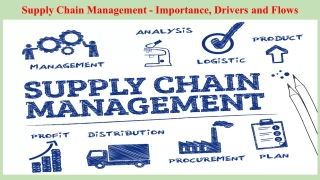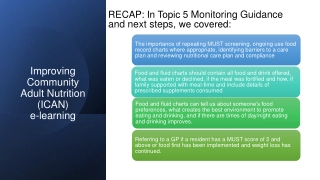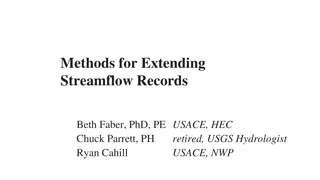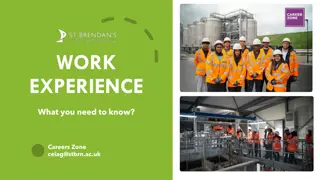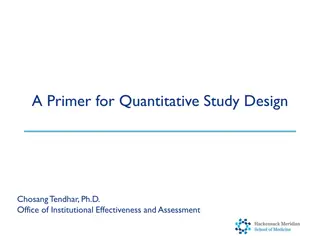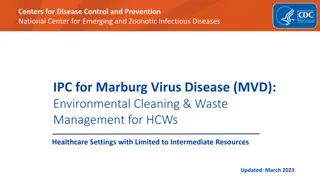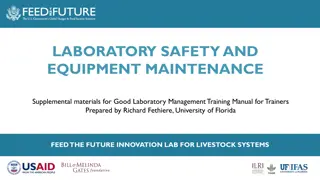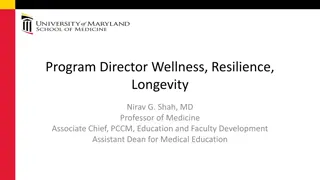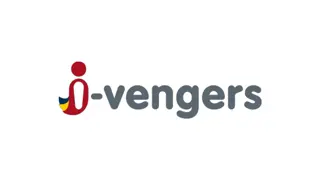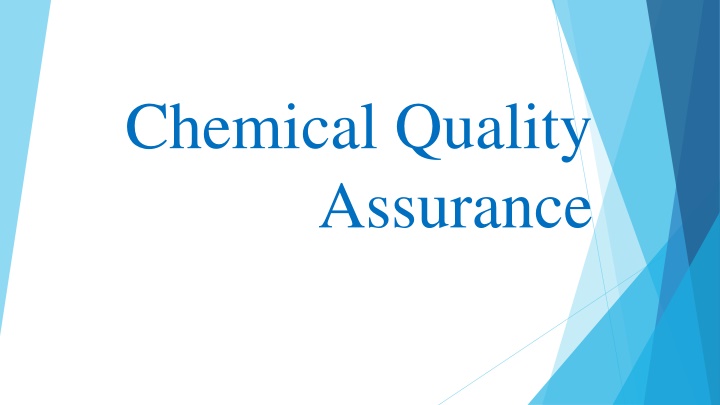
Importance of Chemical Quality Control in Dairy Industry for Improved Milk Products
Learn about the significance of chemical quality control in the dairy industry to combat milk adulteration, ensure high raw milk quality, build consumer trust, boost export potential, and enhance revenue. Discover the concepts and practices of quality assurance and quality control as per ISO standards to maintain product quality and meet consumer needs effectively.
Download Presentation

Please find below an Image/Link to download the presentation.
The content on the website is provided AS IS for your information and personal use only. It may not be sold, licensed, or shared on other websites without obtaining consent from the author. If you encounter any issues during the download, it is possible that the publisher has removed the file from their server.
You are allowed to download the files provided on this website for personal or commercial use, subject to the condition that they are used lawfully. All files are the property of their respective owners.
The content on the website is provided AS IS for your information and personal use only. It may not be sold, licensed, or shared on other websites without obtaining consent from the author.
E N D
Presentation Transcript
Chemical Quality Assurance
CONCEPT AND IMPORTANCE OF CHEMICAL QUALITY CONTROL IN DAIRY INDUSTRY The strict quality control both chemical and microbiological will deter the adulteration of milk improve the quality of raw milk. Improvement of raw milk quality through regular checks improve the prepared from such milk. quality of milk products
install confidence in national consumers, who are drifting away from the indigenous milk products. It will also increase export potential of Indian milk products finally the National image with reference to Indian milk quality. strict quality control will also increase the revenue of a dairy producer.
Quality Control and Quality Assurance As per ISO: 8402 (1994): Quality is the totality of features and characteristics of a product or service that bear (determine) on its ability to satisfy stated or implied needs (requirements) Quality 1/variability Quality control (QC) involves the set of activities used to ensure that the products and services meet / fulfill requirements for quality .
Traditionally Q.C. laboratory function only and is related to analysis of samples i.e. testing and judging of raw materials/ and finished products for acceptance or rejection. Purpose & Aim: To ensure that products are within the well defined and accepted standards thereby protecting the legal and health rights of consumers and financial interests of producers / manufacturers. Limitations : Recall of products is more because products are tested in the
Quality assurance (QA): The set of activities which ensures that quality levels of products and services are properly maintained and the supplier and customer quality issues are properly resolved. Quality assurance gives adequate confidence that product or service will satisfy given requirements for quality.
Purpose/Aim: Internal purpose: Within an organization QA provides confidence to the management. External purpose: Outside the organization provides confidence to consumers or others. Compared to QC, QA is much wider in the sense, it demands full control over the quality of raw materials, control over the process at different levels and control over distribution set up etc. Notion is that Prevention rather than Detection. It is a proactive approach rather than a reactive approach.
OBJECTIVES AND IMPORTANCE OF QUALITY ASSURANCE 1. To maintain legal standards and legal requirements 2. To fulfill customer s requirement in terms of various attributes Physical (body, texture, colour, etc) Chemical composition Microbiological Safety Consumers should get what they pay for This leads to increased consumer satisfaction and less complaints 3.To check adulteration in incoming material => prevent substandard product, hazards or problems in the process .
4.To check efficiency of processes : heating, cooling, removing hardness from water , effluent treatment etc. 5.To safeguard nutritive value of milk and milk products 6.To check wastage of material 7.To help in research and developments 8.To ensure general cleanliness and sanitation in factory premises
BENEFITS Reduction in unit cost of production Reduction in wastage and scrape Less complaints from customer Avoids repeated inspection Increases production since rejection reduces Efficiency of unit goes up Management gets proud place in society Boost employee s morale Reduction in production bottlenecks
ROLE OF QUALITY ASSURANCE DEPARTMENT Sanitation- defines requirements for cleaning and sanitary activity and their monitoring Sanitation standard operating procedure (SSOP) Standard operating procedure (SOP) Good manufacturing practices (GMP) Foreign material control Quality control- Chemical and Microbiological testing Documentation control Pest control
Hazardous material control Allergen Protocol for controlling allergenic material Record control- identification and maintenance Calibration Water quality and water treatment programmes Sensory training and sensory evaluation Supplier certification and ongoing supplier evaluations Receiving, storage and control of raw ingredients and packaging material Control of non-conforming product and process
Product identification traceability and Product recall Handling customer s complaints Labeling- application and control of labels Preventive maintenance Formalized management review process Wastewater (effluent treatment programme) Training Corrective/preventive action - root cause analysis and follow up evaluation to confirm effectiveness of action taken and Internal auditing
Statistical Quality Control (SQC) During the World War II, there was a tremendous requirement for mass production of weapons and other materials, which necessitated the concept of Quality control by making use of statistical tools. This use of statistical tools in controlling the processes was termed => Statistical Quality Control. This was an extension of the inspection phase where inspectors provided with a few statistical tools, such as sampling plans and control charts.
Most significant contribution was => sampling inspection, rather than total inspection. It is collection, analysis and interpretation of data to => solve a particular problem. SQC concept provides a basis for => determining a good or acceptable process behavior model. Any deviation from the model can be traced, identified & eliminated from a process => so that it continues to produce product of acceptable quality.
Demings Philosophy: Adward Deming proposed concept of quality assurance =>involves both process monitoring and eliminating the causes of unsatisfactory performance at all stages. name given to entire cycle of activities through which the fitness for use of process, product or service is achieved, with a view to carry out a company squality function in accordance with the laid down quality objective and policies. has divided quality control into four activities i.e. 1) Plan 2) Do 3) Check and 4) Act. known as Deming sPDCA cycle/wheel.
Plan Establish goals Standardize working procedures Train employees Do Carry out the work according to plan Check Verify for compliance with the plan Act In case of non-compliance => find out and remove its root cause(s) Deming s PDCA cycle applies to all situations and area where quality control is needed (wanted). universal model => covers all activities relating to Quality Control , Quality Assurance as well as Quality Improvement.
Quality Control (QC) During the passage of time => a separate Quality control department came into existence in each factory. The QC department devoted itself primarily to => quality functions. Role of QC department => examine the finished product with a view to verify whether it fulfilled requirements for quality or not.
Total Quality Control (TQC) Quality functions cannot be truly achieved by QC department alone Department depends on help rendered by almost all other departments of the company to => achieve the goals (7 departments) Field force determines => qualityneeds of the consumers (users) Research and development department creates => a product concept which can meet these needs Chemist or design engineer then prepare => product and material specifications suitable for => the required quality and specify procedures and instruments to measure the quality
Purchase department procure => material of the right quality . Plant operators use processes and equipments to => manufacture product . Inspectors measure => quality attributes and determine fitness of the product for use. Sales department => market product and take care at pre-sale stage, on-sale stage and after sale stage. Field force gives consumers reaction => it creates opportunities for the product improvement which in turn restarts the whole cycle of activities.
TQC is an integrated organizational approach to delight customers by => meeting their expectations on a continuous basis through involvement of everyone in the organization. It is an effective system of integrating quality development, quality maintenance and quality improvement efforts of various groups in an organization to provide product or service at the most economical levels and which meet full customers satisfaction. It helps in minimizing rejection and rework.
Quality Assurance (QA) ISO:8402 (1994) - comprises planned and systematic activities implemented within quality system to provide adequate confidence that a given entity (process/product/service) will fulfill requirements for quality All QA activities serve to build confidence internally among => management of organization and externally among its => customers and authorities. To build confidence, quality assurance has to be built into the process => which includes creating records, documenting plans, documenting specifications and reporting reviews. Such activities and documentation serves to => control quality as well as assure it.
Total Quality Management (TQM) TQM => an integrated organizational approach in delighting customers by meeting their expectations on a continuous basis through everyone involved with the organization working on continuous improvement in all spheres namely- process, products and service along with proper problem-solving methodology. Tools = SQC, QC, TQC, QA : often solve problem in one area of business such as => quality of supply or excellence in manufacturing. So what is required is a process designed to focus on customer expectation preventing problems building commitment to quality in workforce promoting open decision making TQM is a journey => it is the path as well as the goal.
Basic principles of TQM Be customer focused place the customer at the centre of everything you do Do it right first time and every time - quality first and always Continuous improvement by using the tool of PDCA in every aspect of work Communicate and educate Improve communication - tell the people what is going on Educate - train the people and retain them
Measure and recorded While finalizing the goals, the Quality indicators (measurements) should be finalized. Record the measures as per prescribed documentation It allows the company to make decisions based on facts, not opinion. Do it together- introduce team working Reduces conflict and in-fighting and increases trust and respect Biting problems with wider range of skill therefore better and more balance solution
Benefits of TQM TQM can bring several benefits for consumers, company and employee, if implemented properly. For customers Greater care Value for money Greater satisfaction Better availability Result in better customer loyalty.
For company (organization) Continuous improvement in quality Reduction in cost Increase in productivity Better motivated work force Defects are reduced Faster solution of problems Result in increased cash flow and net profit
For employees Empowerment More respect More training and better skill Appreciation and recognition Work satisfaction

